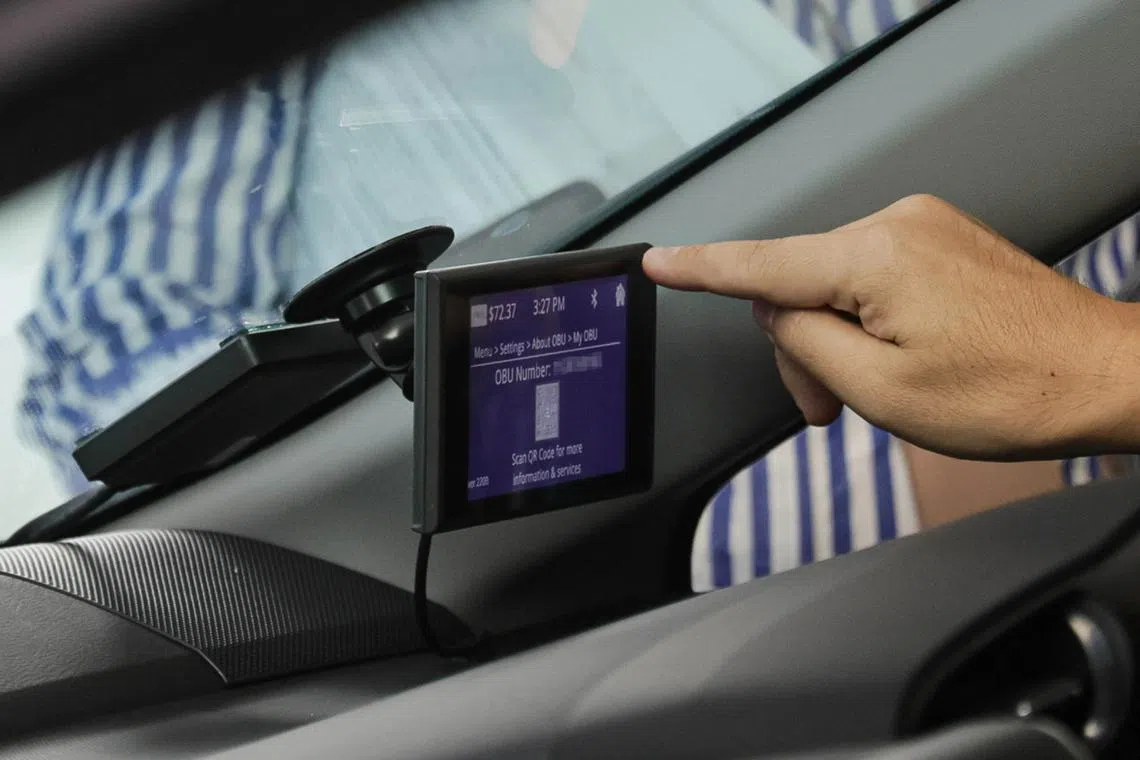LTA refutes claims that ERP 2.0 on-board units do not meet global standards
Sign up now: Get ST's newsletters delivered to your inbox

LTA said the OBU meets the relevant global benchmarks for electronic devices and, when installed properly, is safe and reliable in Singapore’s operating environment.
PHOTO: ST FILE
Follow topic:
SINGAPORE – The Land Transport Authority (LTA) has refuted allegations that the on-board units (OBUs) for the next-generation Electronic Road Pricing system,
In a press statement on May 14, LTA said the OBU meets the relevant global benchmarks for electronic devices and, when installed properly, is safe and reliable in Singapore’s operating environment.
Responding to online comments, LTA noted that the OBU had been tested against the International Electrotechnical Commission’s IEC-60068 and IEC-60529 standards, which are widely used to assess the operational reliability of electronic devices.
The IEC-60068 is a method for the environmental testing of electronic equipment, while the IEC-60529 rates the resistance of electronic devices against the intrusion of dust and liquids.
To qualify for these standards, the OBU passed a wide range of tests, including those for temperature and humidity, added LTA.
The authority reiterated Transport Minister Chee Hong Tat’s parliamentary reply to Workers’ Party MP Louis Chua’s question on May 8 about whether the OBU meets the minimum standards
Mr Chee had said that a series of tests was done on the unit to ensure its reliability for use in Singapore’s weather conditions, and to ensure it would not pose safety risks during accidents.
LTA further clarified that the AEC-Q100 is not the correct standard for assessing electronic devices such as the OBU, as it is a technical standard used to measure packaged integrated circuits used in vehicles, like the chips in the in-car entertainment system.
The AEC-Q100 focuses on the quality of individual parts and is not meant for devices comprising many components, added the authority.
The three-piece OBU consists of a processing unit, an antenna and a touchscreen display.
The authority said the processing unit is different from devices such as the existing ERP in-vehicle unit and a vehicle dashcam, or the OBU’s antenna and touchscreen display, which are either passive or do not have the same computing functions as the processing unit.
A more relevant comparison with the processing unit, said LTA, is a smartphone, which functions similarly like a mini-computer.
LTA said a smartphone could overheat and stop working temporarily if it is left in a holder near the dashboard for a few hours under the hot sun.
Citing a technical advisory by smartphone maker Apple, LTA noted that Apple devices should be stored at between minus 20 deg C and 45 deg C, and users should not leave their iPhones in a parked car on a hot day.
For the same reason, the authority does not recommend placing the processing unit on the dashboard, as the temperature there could reach 50 deg C to 52 deg C on a hot day, compared with 38 deg C to 39 deg C at the footwell.
In response to The Straits Times’ query on the acceptable temperature range, LTA said the processing unit’s functioning and reliability will be affected at temperatures above 50 deg C.
The heat tolerance of the OBU has become a hot topic in recent weeks, with LTA posting a video to its social media channels on April 29 explaining why the OBU for cars comes in three parts – instead of a one-piece unit that motorcycles have.
The video noted that the one-piece motorcycle OBU is designed for outdoor conditions, and is unsuitable for the enclosed interior of a car. If placed on a car’s dashboard, an item can heat up to 52.4 deg C.
In comparison, the temperature at a car’s footwell goes up to 38.7 deg C, close to the 34.1 deg C on a motorcycle parked outdoors, said LTA in the video.
The authority cited this as the reason for positioning the processing unit away from the dashboard.
The issue resurfaced on May 8 when Mr Chua raised the question on the OBU’s safety standards in Parliament, which led some social media users to claim that the unit was prone to overheating risks due to a design flaw.
About 2 per cent, or 18,000, of almost one million vehicles here have been fitted with the OBUs since August 2023.
The installation of the new OBUs started for fleet vehicles, such as buses and motorcycles, in November 2023, while new vehicles registered from May 1 would be pre-fitted with them.
Owners of Singapore-registered cars will be notified progressively in the second half of 2024 when they are supposed to have the OBU installed.

